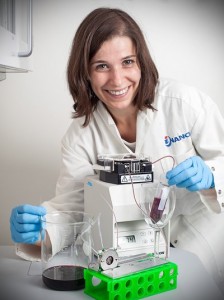Denmark is not the first country that pops to mind when there’s mention of a nanosensor that mimics what happens in your mouth when you drink wine but that’s where the device was developed. From a Sept. 17, 2014 news item on ScienceDaily,
When wine growers turn their grapes into wine, they need to control a number of processes to bring out the desired flavour in the product that ends up in the wine bottle. An important part of the taste is known in wine terminology as astringency, and it is characteristic of the dry sensation you get in your mouth when you drink red wine in particular. It is the tannins in the wine that bring out the sensation that — otherwise beyond compare — can be likened to biting into an unripe banana. It is mixed with lots of tastes in the wine and feels both soft and dry.
…
Researchers at the Interdisciplinary Nanoscience Centre (iNANO ), Aarhus University, have now developed a nanosensor that is capable of measuring the effect of astringency in your mouth when you drink wine.
A Sept. 17, 2014 Aarhus University (Denmark) press release (also on EurekAlert), which originated the news item, provides a general description of the sensor,
… To put it simply, the sensor is a kind of mini-mouth that uses salivary proteins to measure the sensation that occurs in your mouth when you drink wine. The researchers are looking at how the proteins change in the interaction with the wine, and they can use this to describe the effect of the wine.
There is great potential in this – both for the wine producers and for research into the medicine of the future. Indeed, it is the first time that a sensor has been produced that not only measures the amount of proteins and molecules in your mouth when you drink wine, but also measures the effect of wine – or other substances – entering your mouth.
The wine producers’ perspective is introduced (from the news release),
The sensor makes it possible for wine producers to control the development of astringency during wine production because they can measure the level of astringency in the wine right from the beginning of the process. This can currently only be achieved when the wine is ready and only by using a professional tasting panel – with the associated risk of human inaccuracy. Using the sensor, producers can work towards the desired sensation of dryness before the wine is ready.
“We don’t want to replace the wine taster. We just want a tool that is useful in wine production. When you produce wine, you know that the finished product should have a distinct taste with a certain level of astringency. If it doesn’t work, people won’t drink the wine,” says PhD student Joana Guerreiro, first author of the scientific article in ACS NANO, which presents the sensor and its prospects.
Better Understanding of Astringency
There are many different elements in wine that create astringency, and this makes it difficult to measure because there are so many parameters. The sensor turns this upside down by measuring the molecules in your mouth instead.
“The sensor expands our understanding of the concept of astringency. The sensation arises because of the interaction between small organic molecules in the wine and proteins in your mouth. This interaction gets the proteins to change their structure and clump together. Until now, the focus has been on the clumping together that takes place fairly late in the process. With the sensor, we’ve developed a method that mimics the binding and change in the structure of the proteins, i.e. the early part of the process. It’s a more sensitive method, and it reproduces the effect of the astringency better,” says Joana Guerreiro.
There are also some technical details in the news release,
Quite specifically, the sensor is a small plate coated with nanoscale gold particles. On this plate, the researchers simulate what happens in your mouth by first adding some of the proteins contained in your saliva. After this they add the wine. The gold particles on the plate act as nano-optics and make it possible to focus a beam of light below the diffraction limit so as to precisely measure something that is very small – right down to 20 nanometres. This makes it possible to study and follow the proteins, and to see what effect the wine has. It is thereby possible to see the extent to which the small molecules have to bind together for the clumping effect on the protein to be set off.
The technique in itself is not new. What is new is using it to create a sensor that can measure an effect rather than just a number of molecules. In this case, the effect is the dry sensation you get in your mouth when you drink wine. However, it is also possible to use the sensor to measure other effects.
Here’s a look at the Mini-mouth,

PhD student Joana Guerreiro has taken part in developing a sensor, which – by using nanoscience – can measure how we experience the feeling of dryness in wine. Photo: Lars Kruse, Aarhus University.
Here’s a link to and a citation for the paper,
Multifunctional Biosensor Based on Localized Surface Plasmon Resonance for Monitoring Small Molecule–Protein Interaction by Joana Rafaela Lara Guerreiro, Maj Frederiksen, Vladimir E. Bochenkov, Victor De Freitas, Maria Goreti Ferreira Sales, and Duncan Steward Sutherland. ACS Nano, 2014, 8 (8), pp 7958–7967 DOI: 10.1021/nn501962y Publication Date (Web): July 8, 2014
Copyright © 2014 American Chemical Society
This paper is behind a paywall.
ETA Sept. 19, 2014: Dexter Johnson provides some insight into the field of ‘artificial mouths’ in his Sept. 18, 2014 posting (Nanoclast blog on the IEEE [Institute of Electrical and Electronics Engineers] about the work in Denmark.